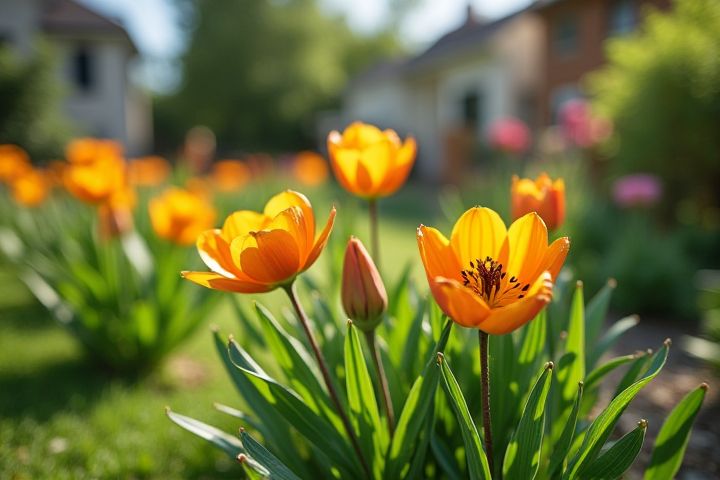
Gardening at a rental house is entirely feasible, provided you understand the terms of your lease agreement and the property's regulations. Check with your landlord to ensure that modifications to the landscape are permitted, as some rental agreements may prohibit significant alterations. Container gardening offers a great solution, allowing you to grow flowers, vegetables, or herbs without altering the soil or existing garden structure. Consider using raised beds, which can be a temporary solution, as they can be dismantled upon moving out. By nurturing a garden, you can enhance your living space and enjoy fresh produce, all while elevating the aesthetic value of the rental property.
Can You Garden At A Rental House
Check lease agreement for guidelines
Check your lease agreement for specific guidelines regarding gardening at your rental house, as many agreements contain clauses that outline what tenants can and cannot do. Typically, landlords may impose restrictions on modifying outdoor spaces or planting flowers and vegetables without prior consent. If allowed, be sure to inquire about any required approvals for landscaping changes or specific types of plants that may be prohibited. By understanding your lease terms, you can enjoy gardening while maintaining a positive relationship with your landlord and adhering to their rules.
Get landlord permission
Obtaining landlord permission is essential before starting a garden at your rental house. Many landlords appreciate tenants who maintain the property and enhance its aesthetics, but written approval ensures both parties are aligned on garden scope and maintenance responsibilities. Discuss your gardening plans, including the type of plants, location, and any modifications to the landscape, to avoid any disputes. Having a clear agreement not only protects your gardening efforts but also fosters a positive tenant-landlord relationship.
Use portable gardening options
You can easily garden at a rental house by utilizing portable gardening options such as container gardens, vertical planters, and raised beds. These mobile gardening solutions allow you to customize your green space while adhering to rental agreements that often restrict permanent installations. Consider using lightweight materials like fabric pots or plastic containers, which not only promote good drainage but are also easy to move. With creativity, you can cultivate vegetables, herbs, or ornamental plants without damaging the property, making gardening a fulfilling option for renters.
Consider container gardening
You can successfully garden at a rental house by focusing on container gardening, which offers flexibility and mobility. Utilizing pots, raised beds, and decorative planters allows you to cultivate a variety of plants, from herbs to vegetables, without disturbing the property. This method not only maximizes space but also enables you to adapt your garden style to changing seasons or relocation needs. Container gardening simplifies maintenance and enhances your outdoor area, making it both vibrant and sustainable.
Research local regulations
Researching local regulations is crucial when considering gardening at a rental house, as rules can vary significantly by location. Many municipalities have specific zoning laws that dictate what types of plants are allowed, as well as whether you can modify the yard landscaping. Always check with your landlord about any restrictions on altering the property, and consult the city or county guidelines to ensure compliance. Engaging in community gardening projects may also be an option, allowing you to cultivate plants while adhering to local policies.
Plan for minimal damage to property
You can certainly garden at a rental house while minimizing damage to the property. Start by using container gardening, which allows you to grow plants without altering the soil or structure of the garden beds. Select non-invasive plants that won't harm existing landscaping and choose portable planters that can be easily moved. Always check your lease agreement for any restrictions or requirements that might affect your gardening plans, ensuring that your green thumb leaves no permanent marks.
Be aware of pest control measures
When gardening at a rental house, it's crucial to be aware of pest control measures, especially if you want to maintain a healthy garden. You should consult your landlord about any existing pest control treatments to prevent negative interactions with your plants. Using organic pest control methods, such as beneficial insects and natural repellents, can help keep your garden free of harmful pests while adhering to non-toxic standards. Regular monitoring of your plants for signs of pests can also contribute to effective management and a thriving garden.
Choose low-maintenance plants
When considering gardening at a rental house, opting for low-maintenance plants is crucial for both aesthetics and practicality. Varieties such as succulents, lavender, and daylilies require minimal watering and can thrive in various conditions, making them perfect for transient living situations. You can enhance your space with these plants without the commitment of extensive upkeep or permanent changes. This approach not only beautifies your rental but also allows you to enjoy gardening without extensive labor or stress.
Understand potential costs
Gardening at a rental house can enhance your living space and provide fresh produce or beautiful landscaping; however, understanding potential costs is essential. You may face expenses such as soil, seeds, plants, mulch, and any necessary gardening tools, which can quickly add up. If you're considering larger projects, like raised garden beds or irrigation systems, be aware of both initial costs and ongoing maintenance. Always check your lease agreement for any restrictions on modifications to the property, as this could affect your investment in gardening.
Document changes made
Documenting changes made in a garden at a rental house is essential for maintaining a good relationship with your landlord. Start by taking photographs of the garden before any alterations, capturing its original state. When you implement changes, such as planting new flowers or adding raised beds, record these modifications with timestamps and descriptions. This thorough documentation not only protects your security deposit but also provides clear evidence of your improvements for future tenants.
